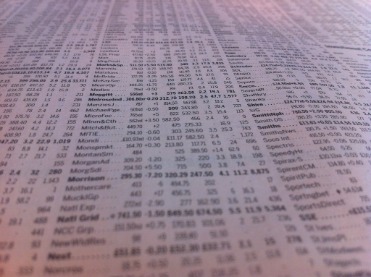
The goal of swing trading is to capture a chunk of a potential price move. While some traders seek out volatile stocks with lots of movement, others may prefer more sedate stocks. Typically, swing trading involves holding a position either long or short for more than one trading session, but usually not longer than several weeks or a couple of months. This is a general time frame, as some trades may last longer than a couple of months, yet the trader may still consider them swing trades.

But if you have the tolerance, risk capital, and willingness to learn to swing trade, you might find it a valuable skill that could potentially supplement your longer-term investments. Most traders prefer using the Japanese candlestick charts since they are easier to understand and interpret. Traders use specific candlestick patterns to identify trading opportunities. Identify a stock or ETF where the weekly trend is up and the bottoms on the daily bar chart tend to be short and sharp. Analyze how the stock or ETF has behaved since the beginning of the trend. Swing traders should select their candidates from the most actively traded stocks and ETFs that show a tendency to swing within broad, well-defined channels.
Support and resistance trades are trend continuation trades, meaning we’re looking to find a favorable point to enter in the direction of the trend. Trend pullbacks, while probably being the most accessible type of pattern to trade and having the best odds of continuation, aren’t the most exciting trades. Swing traders also pay fewer commissions, fees, and slippage, and these fees have a smaller impact on their trades because their profits are larger per trade. Day trading may be a good choice for those who want higher profit potential, while swing trading may suit those who want a lower-stress option. To begin day trading, you’ll need to have an account set up with a broker and have a computer system and software that allow you to see and access all of the information you need.

Because their trades take days to unfold, they aren’t required to sit at their screens, watching each tick go by. There are a ton of different swing trading strategies so we decided cover a couple of our favorites that are easy to understand and trade. Swing trading and day trading both require a good deal of work and knowledge to generate profits consistently. Day trading uses multiple trades throughout one or two trading days to gather as many small profits as possible on daily price changes. MAs are referred to as lagging indicators because they look back over past price action. The longer the period covered by a moving average, the more it lags.
As you can see, before recommending a stock to users, Rule Breakers considers a number of factors. In short, the service mainly looks for well-run companies in emerging industries with a sustainable advantage over competitors, among other factors. Use Seeking Alpha Premium’s Seeking Alpha Stock Ratings to find stocks likely to outperform and make you money. Consider starting a subscription to take advantage of SA’s Premium services and see if they make sense for your needs. This plan includes a stock screener letting you filter by average analyst rating and gain access to listen to conference calls and other presentations.
How much https://forex-trend.net/ you need to begin swing or day trading depends on what you’re going to be trading rather than how you’re going to trade. Forex, stocks, and futures all require different amounts of capital to start with. For example, if you’re swing trading off a daily chart, you could find new trades and update orders on current positions in about 45 minutes per night.
Moving averages
These traders usually make the most money when their stocks trend upward for several hours. Scalpers mostly use price action to find entry and exit positions. Price action is the process of identifying patterns and predicting the next moves.

Swing traders will typically look at medium to high time frame charts. A strong uptrend or downtrend has to be confirmed on a higher time frame. But, they may also look at intraday time frames, such as the 1-hour, 4-hour, 12-hour chart, to look for specific entry and exit points.
Breakdown Strategy
As a provider of educational courses, we do not have access to the personal trading accounts or brokerage statements of our customers. As a result, we have no reason to believe our customers perform better or worse than traders as a whole. Ross Cameron’s experience with trading is not typical, nor is the experience of traders featured in testimonials. Becoming an experienced trader takes hard work, dedication and a significant amount of time.
- He even helped Dogecoin , which started as a joke, rally in 2021, so when trading crypto, consider that external noise can cause volatility.
- Swing trading seeks to capitalize on the upward and downward “swings” in the price of a security.
- Their results speak for themselves and easily justify the affordable price tag of $99 for the first year.
- Likewise, where a swing trader differs from a day trader as well is with risk tolerance.
- But swing trading is still a business, so you must stick to certain rules designed to keep you in the game.
- And since you now know what it takes to be a successful swing trader, you can avoid the common pitfalls yourself and get started on the right foot.
In contrast, https://topforexnews.org/ is where the selling of the security sets off. After entering a swing trade, place a protective stop reasonably close to your entry point. Stops and money management are essential for your survival and success. Trend analysis is a technique used in technical analysis that attempts to predict future stock price movements based on recently observed trend data.
Manage risks: Set a profit target or technical exit
Market swings present investors with an opportunity to accumulate security’s at a discounted price. For example, a 10% drop in the Standard and Poor’s 500 index (S&P 500) allows investors to add some quality names to their portfolio. To manage risk during a market swing, investors can dollar cost average into a stock. To do this, the investor purchases a fixed dollar amount of shares in intervals. For instance, if an investor wants to invest $50,000 into a stock, they might buy it in five $10,000 allotments.

Consequently any person acting on it does so entirely at their own risk. Any research provided does not have regard to the specific investment objectives, financial situation and needs of any specific person who may receive it. It has not been prepared in accordance with legal requirements designed to promote the independence of investment research and as such is considered to be a marketing communication.
And, you can learn swing trading pretty quickly, too – since you only factor in technical analysis. When swing trading stocks it is essential to choose the right assets to trade, as bad market selection could be a major weakness in your trading strategy. Support and resistance lines represent the cornerstone of technical analysis and you can build a successful stock swing trading strategy around them. Swing traders may track trends in performance, momentum or volume.
However, the most important time frame for swing trading is likely the daily chart. Even so, trading and investment strategies can differ substantially between different traders. Note that what we’ve discussed here aren’t strict rules, but just common examples. There are several different trading strategies often used by swing traders. Swing trading refers to the medium-term trading style that is used by forex traders who try to profit from price swings.
] that mathematical models and algorithms do not work for every instrument or market situation. Volatile, making big price jumps quickly or move very little and be hard to exit at a reasonable price. The best stock indicators for swing trading are support and resistance levels on technical charts. That means buying long at support levels, selling or shorting into resistance levels, and covering at support levels are what traders should strive for when swing trading. One of the key characteristics of the most successful swing traders is the ability to trade without emotion. The ability to cut losses and keep them small – rather than holding on and hoping for a rebound – will prevent you from blowing up your portfolio.
This website is using a https://en.forexbrokerslist.site/ service to protect itself from online attacks. There are several actions that could trigger this block including submitting a certain word or phrase, a SQL command or malformed data. IG International Limited is licensed to conduct investment business and digital asset business by the Bermuda Monetary Authority. Discover the range of markets and learn how they work – with IG Academy’s online course. The EOM indicator is plotted on a chart with zero as the base line.
Support and resistance levels are vital for interpreting chart patterns, identifying trend direction, and entry and exit points. Therefore, swing traders should apply an appropriate strategy to each market environment. Swing trading, like other styles of trading, has its advantages and disadvantages.